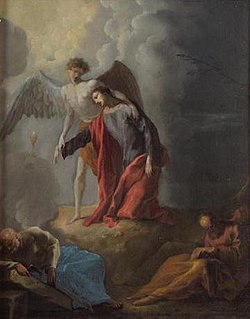
Matthew 5:15 and Matthew 5:16 are the fifteenth and sixteenth verses of the fifth chapter of the Gospel of Matthew in the New Testament. They are part of the Sermon on the Mount, and is one of a series of metaphors often seen as adding to the Beatitudes. The previous verse compared the disciples to a City upon a Hill that can't be hidden. These verses present a similar analogy.

Matthew 5:22 is the twenty-second verse of the fifth chapter of the Gospel of Matthew in the New Testament and is part of the Sermon on the Mount. It is the first of what have traditionally been known as the 6 Antitheses. In this one, Jesus compares the current interpretation of "You shall not murder" from the Ten Commandments with his own interpretation.

Matthew 5:26 is the twenty-sixth verse of the fifth chapter of the Gospel of Matthew in the New Testament and is part of the Sermon on the Mount. Jesus has just warned that if you do not reconcile with your enemies a judge is likely to throw you in jail. In this verse Jesus mentions that your debts must be paid completely before one can leave.

Matthew 5:33 is the thirty-third verse of the fifth chapter of the Gospel of Matthew in the New Testament and is part of the Sermon on the Mount. This verse is the opening of the fourth antithesis, beginning the discussion of oaths.

Matthew 5:41 is the forty-first verse of the fifth chapter of the Gospel of Matthew in the New Testament and is part of the Sermon on the Mount. This is the fourth verse of the antithesis on the commandment: "Eye for an eye".

The Parable of the Wise and the Foolish Builders, is a parable of Jesus appearing in the Gospel of Matthew and Luke.

Matthew 7 is the seventh chapter of the Gospel of Matthew in the New Testament. The chapter is the last of the three chapters which comprise the Sermon on the Mount.

Matthew 7:19 and Matthew 7:20 are the nineteenth and twentieth verses of the seventh chapter of the Gospel of Matthew in the New Testament and are part of the Sermon on the Mount. The verses continue the section warning against false prophets.

Matthew 7:21 is the twenty-first verse of the seventh chapter of the Gospel of Matthew in the New Testament and is part of the Sermon on the Mount. This verse continues Jesus' warning against false prophets.

Matthew 28:1 is the first verse of the twenty-eighth chapter of the Gospel of Matthew in the New Testament. This verse opens the resurrection narrative as Mary Magdalene and "the other Mary" visit Jesus' tomb after the crucifixion.

Matthew 28:4 is the fourth verse of the twenty-eighth chapter of the Gospel of Matthew in the New Testament. This verse is part of the resurrection narrative; describing the reaction of the tomb guards after the arrival of the angel of the Lord and the occurrence of an earthquake that opened the tomb.

Matthew 28:10 is the tenth verse of the twenty-eighth chapter in the Gospel of Matthew in the New Testament. This verse is part of the resurrection narrative. Mary Magdalene and "the other Mary" are leaving the empty tomb of Jesus after encountering an angel, and in this verse they encounter the risen Jesus.
Matthew 28:11 is the eleventh verse of the twenty-eighth chapter of the Gospel of Matthew in the New Testament. This verse is part of the resurrection narrative. In this verse the guards of the tomb, after being present for an angel hearkening the resurrection, return to report to Jerusalem.
Matthew 28:12 is the twelfth verse of the twenty-eighth chapter of the Gospel of Matthew in the New Testament. This verse is part of the resurrection narrative. In this verse the guards of the tomb, after being present for an angel hearkening the resurrection, are bribed by the priests to lie about what they saw.

Matthew 7:25 is the twenty-fifth verse of the seventh chapter of the Gospel of Matthew in the New Testament and is part of the Sermon on the Mount. This verse continues the Parable of the Wise and the Foolish Builders.

Matthew 7:26 is the twenty-sixth verse of the seventh chapter of the Gospel of Matthew in the New Testament and is part of the Sermon on the Mount. This verse continues the Parable of the Wise and the Foolish Builders.

Matthew 7:27 is the twenty-seventh verse of the seventh chapter of the Gospel of Matthew in the New Testament. This verse finishes the Parable of the Wise and the Foolish Builders and is the closing verse of the Sermon on the Mount.

Matthew 7:28 is the twenty-eighth verse of the seventh chapter of the Gospel of Matthew in the New Testament. It forms the first part of a two verse conclusion following the Sermon on the Mount.

Matthew 7:29 is the twenty-ninth verse in the seventh chapter of the Gospel of Matthew in the New Testament. It ends a two verse conclusion following the Sermon on the Mount.

Matthew 10:1 is the first verse of the tenth chapter of the Gospel of Matthew in the New Testament. In this verse Jesus gathers his disciples and grants them healing powers in what is known as the commissioning the twelve apostles.


















